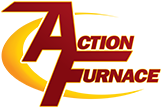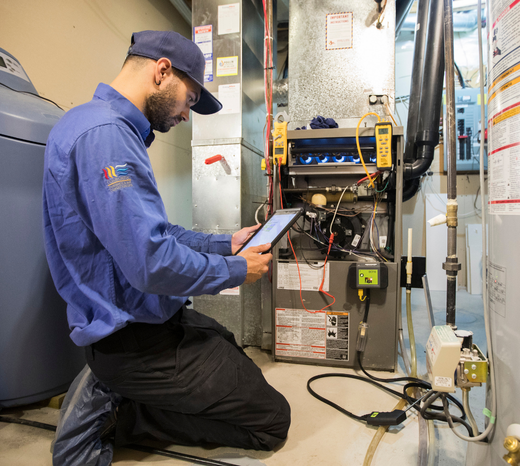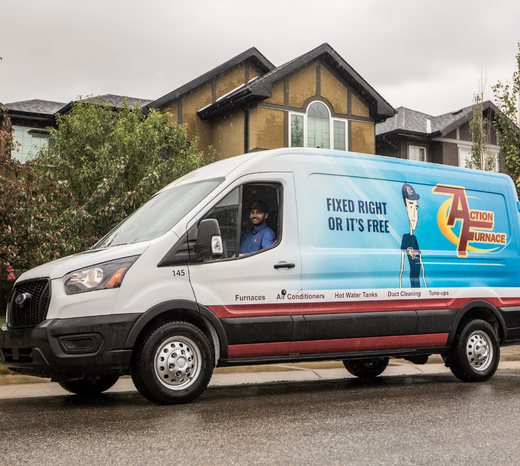To say Alberta’s winters can be harsh is putting it mildly—so it might be time to think about replacing your heating system with a new forced-air furnace. Learn what to look for and what to expect from the process in this handy buyer’s guide for 2024.
...

Keeping your home warm throughout years of cold Alberta winters eventually means buying a new furnace—but there are a lot of questions to answer before you do, which is why our team at Action Furnace created this guide.
Below, we walk you through when to replace your furnace, what different kinds to choose from, how to install and maintain them, and why you benefit from upgrading to an energy-efficient new model.
Get a Quote for Your New Furnace Installation
When to Buy a New Furnace: Replacing vs. Repairing
Not all furnace issues require you to buy a new model—but sometimes, it’s more cost-effective in the long run to replace your furnace than to spend money fixing a persistent or severe problem.
We’ve listed a few guidelines that can help you tell the difference below. For a deeper dive, check out this guide: Should I Repair or Replace My Furnace?
Repair Your Furnace If
- Your Furnace Is Under 10 Years Old. In most cases, furnace repairs within the first decade of owning a unit will be considerably less expensive than purchasing a new one.
- You Have Minor Wear & Tear. Many furnace components require regular cleaning or replacement during the expected lifespan of the unit. Replacing something like a broken blower motor is more cost-effective than buying a new furnace unless the problem is recurring frequently.
- Your Furnace Issues Do Not Affect Performance or Safety. If your furnace problems do not impact your ability to safely heat your home, there may not be an urgent need for replacement.
Replace Your Furnace If
- Your Furnace Is Over a Decade Old. Older units experience breakdowns more frequently, and repair costs can add up to the point where replacement is ultimately cheaper.
- You Experience Frequent Breakdowns. If your furnace is struggling to safely and consistently provide heat throughout the home and you’ve already tried to repair the problem, consider a replacement.
- Your Energy Bills Are Steadily Rising: All furnaces get less efficient over time, and new models are built to higher energy efficiency standards. Replacing your furnace can not only prevent your bills from climbing, it can save you up to 30% on your current heating bills.
What Kind of Furnace to Buy
High-Efficiency vs. Regular Furnaces
New high-efficiency furnaces have significantly higher AFUE (Annual Fuel Utilization Efficiency) ratings than older models. An AFUE rating is a measure how efficiently a furnace converts the energy in its fuel to heat over the course of a typical year (i.e. an AFUE rating of 90 means that 90% of the fuel used gets converted to heat).
| High-Efficiency Furnaces | Regular Furnaces | |
| Efficiency Ratings | AFUE ≥ 90% | AFUE 80-89% (lower over time) |
| Cost | More expensive upfront, but saves on energy bills in the long run | Less expensive initially, but more expensive to run over time |
| Environmental Impact | Lower greenhouse gas emissions | Higher emissions |
Comparison Chart: Furnace Types At a Glance
Most forced-air furnaces in Alberta homes use one of the following fuel sources: gas, propane, oil, or electricity. Each type requires different technology and has unique pros and cons. Here’s a breakdown of the differences.
| Average Lifespan | Upfront Cost | Running Costs | Fuel Efficiency | Ease of Maintenance | |
| Natural Gas | 15-20 years | $$ | $$ | High | Moderate |
| Propane | 15-20 years | $$ | $$$ | Moderate | Moderate |
| Oil | 15-20 years | $$ | $$$ | Low | High |
| Electric | 20-30 years | $ | $$$ | Moderate to High | Low |
Different Types of Furnaces Explained
Natural Gas
How They Work
- Natural gas is ignited in the burner by an electronic ignition system.
- The burning gas heats a metal heat exchanger where the heat is transferred to the air.
- A blower fan moves the heated air into the ductwork to distribute it throughout the home.
- Combustion gases are safely vented out through a flue or chimney.
- The thermostat monitors room temperature and signals the furnace to turn on or off.
- Safety features include an automatic shut-off for gas if the flame goes out or in case of overheating.
Pros:
- Cost-effective.
- Widely available in cities.
- Highly reliable with proper maintenance.
Cons:
- Requires a gas line connection.
Ideal For:
Homeowners in urban areas with access to natural gas.
Propane
How They Work
- Propane is stored in a tank and piped to the furnace as needed.
- Combustion occurs in a chamber, heating the metal heat exchanger.
- The heat exchanger warms the air while keeping combustion gases separate.
- A fan blows the heated air through ducts to distribute it throughout the home.
- Combustion by-products are expelled safely outside through a vent.
- Thermostat and safety controls respond to temperature changes and ensure safe operation.
Pros:
- More efficient than oil furnaces.
- Suitable for areas without natural gas service.
- Provides strong heating output.
Cons:
- Higher fuel costs than natural gas.
- Requires storage for propane tanks.
Ideal For:
Homeowners in remote areas without natural gas service.
Oil
How They Work
- Oil is stored in a tank and pumped to the furnace when heating is needed.
- The oil is atomized and ignited in the burner.
- The burning oil heats the metal heat exchanger.
- A blower distributes the heated air through the home's ductwork.
- Combustion gases are vented outside through a flue or chimney.
- Safety and efficiency controls prevent overheating and ensure efficient operation.
Pros:
- High heat output, suitable for very cold climates.
- Effective in areas without natural gas access.
Cons:
- Higher running and maintenance costs.
- Requires on-site storage for oil.
Ideal For:
Homeowners in rural areas with limited access to gas.
Electric
How They Work
- Metal coils or elements are heated using electricity.
- Air is blown across these hot elements to warm it.
- The warmed air is then circulated throughout the home via ducts.
- There are no flames or combustion gases, making it safer.
- The thermostat regulates the activation of heating elements based on temperature settings.
- Safety features include overheat protection to prevent fire hazards.
Pros
- Lower initial installation cost.
- No need for fuel storage or a gas line.
Cons
- Higher operating costs due to electricity prices
- Less efficient in extremely cold climates
Ideal For:
Homeowners seeking a safe, easy-to-install option and where electricity costs are lower.
Heat Pumps vs. Furnaces
Heat pumps and furnaces are both capable of heating homes, but they operate quite differently and are best suited to different environments and needs.
Heat Pumps use electricity to transfer heat from the outside air or ground into your home instead of burning fuel. They can be used for both heating and cooling, making them versatile. They’re also energy-efficient, especially in milder climates.
Furnaces, on the other hand, generate heat by burning fuel (like natural gas, oil, or propane) or using electricity. They are typically more effective in colder climates where temperatures drop significantly, as they can produce more heat in a shorter time compared to heat pumps.
Because heat pumps are more efficient in mild to moderate temperatures, some Alberta homeowners use them to supplement their forced-air furnaces. However, they rely on their furnaces during the coldest days of the year, when heat pumps may struggle to produce enough heat efficiently.
We recommend having a high-efficiency natural gas furnace in your home for when the temperature drops well below freezing. If you’re considering adding a heat pump to supplement this system, contact us for advice and we’ll be able to tell you if it’s a viable option for your home.
Purchase Considerations
Once you’ve looked at the different technologies and fuel sources available, you’ll need to make sure you purchase a model capable of heating your home reliably. Here’s how:
Furnace Sizing Guidelines
The “size” of a furnace refers to its heating capacity in a given space.
Furnace sizes can range from 40,000 BTU to 65,000 BTU to even 100,000 BTU depending on the size of your home. That’s why it’s so important to have the experienced Comfort Advisors at Action Furnace size your furnace properly, so you know you’re getting the proper size and power capabilities for your home.
Additional Sizing Factors
However, the sizing process involves more than just considering the square footage of your house. Other factors include:
- Your home's insulation quality
- The number of windows and doors
- Ceiling height
- Climate considerations
An undersized furnace will struggle to heat your home adequately, while an oversized one can lead to inefficiency and increased wear and tear. Learn more about how to determine the right type and size of furnace for your home.
To accurately assess the heating needs of your home, Action Furnace's trained technicians will perform an industry-standard assessment called the Manual-J load calculations. This method takes into account all of the factors above (plus numerous others) to ensure that the furnace selected will be perfectly suited to your home's unique requirements, providing efficient and reliable heating.
Single vs. Multi-Zone Ducting
Adjusting your ductwork to create different climate zones in your home is an upgrade you should consider when planning for a new furnace. Here’s what that means:
- Single-zone ducting refers to a heating system where one thermostat controls the temperature for the entire home. If you don’t have your ductwork partitioned, your home will only have one climate zone.
- Multi-zone ducting allows for different areas (zones) of the home to be heated to different temperatures, controlled by multiple thermostats. This requires your ducts to be partitioned by our home comfort experts.
Partitioning your ducts can provide more personalized comfort for homes with multiple occupants and potentially increase energy efficiency, as you can heat only the areas being used. We can provide a detailed quote for partitioning your ductwork when you contact us to install your new furnace.
See Also: Should I Have a Zoned HVAC System?
Preparing for Your Furnace Installation
Before the installation of your new furnace, take a few steps to prepare your home and ensure the process will be as smooth as possible:
- Clear the Area: Ensure the area where the furnace will be installed is clean and clear of any debris or obstructions—this helps our techs work faster.
- Inspect Ductwork: Check your home’s ductwork for any obvious leaks or damage. We’ll go over this during the installation, but anything you find ahead of time can make our work more efficient.
- Consider the Upgrades You’ll Need: If you haven’t already, think about investing in a smart thermostat, whole-home humidifier, or another indoor air quality solution.
Tips for Using & Maintaining Your New Furnace
Proper use and maintenance are crucial for the longevity and efficiency of your furnace.
- Regular Filter Changes: Change or clean your furnace’s air filter regularly, typically every 1-3 months, to ensure efficient operation. HEPA filters and other high-quality options can last longer. Learn about upgraded furnace filters.
- Annual Professional Maintenance: Schedule annual check-ups with a qualified technician to keep your furnace running smoothly and prevent costly repairs. Book a furnace tune-up.
- Thermostat Settings: Use a programmable thermostat to optimize heating schedules, reducing energy use while maintaining comfort. Smart thermostats can automatically adjust your furnace to maintain optimal energy efficiency and comfort settings.
Why Buy with Action Furnace?
Installing new furnaces is what we do at Action Furnace—and we’re some of the best in Alberta at it. If you’re considering a new furnace for your home, here are a few reasons to choose our team:
Industry Leading Warranties & Guarantees
A 12-year parts and labour warranty, plus compensation offered for breakdowns within the first year, last-minute rescheduling, and more. Plus, get a full refund with interest and the equipment removed if it doesn’t meet your expectations after a two-year trial period!
Membership Benefits
Members of our Comfort Club get 10% off all future HVAC repairs, as well as access to our priority service.
Save Up to 12% on Energy Bills with Annual Furnace Tune-Ups
Regular maintenance by our expert technicians ensures your furnace runs efficiently, potentially saving you up to 12% on your energy bills.
Choosing Action Furnace means choosing reliability, transparency, and a commitment to customer satisfaction. Contact us to book your furnace installation and learn more by exploring the FAQ below.
Frequently Asked Questions about Buying a Furnace
How Much Are New Furnace Installations?
The average price for a new furnace and installation in Canada is between $6500 - $11,000, depending on the heating needs of your home, the quality of the system, and the reliability of your contractors. Avoid “too good to be true” deals, which may be performed by unlicensed contractors using substandard tools or equipment.
How Long Does It Take to Install a Furnace?
Most furnace installations can be performed in under 10 hours, but every home is different—and tasks like breaking up a home into different heating zones can take extra time. When you contact us for furnace replacement, we’ll give you a timeline for the job along with our quote.
What Should My Furnace Sound Like?
Most furnaces hum while running and emit a low blowing noise as air moves throughout the home. These noises should be mild and easy to ignore.
- Abnormal noises that may indicate problems with your furnace include:
- Loud buzzing or humming
- Whistling
- Loud banging or clanging sounds
These noises could be signs of simple problems like dirty filters, but in other cases they could indicate serious issues like leaking fuel. If your furnace is making strange sounds, call us for furnace repair right away.
What’s the Average Cost to Run a Furnace in the Winter?
Running a furnace usually costs $50-$150 per month during cold weather, but efficiency problems or extreme temperatures can drive up costs. Because newer furnaces are more energy efficient, they can lower your heating costs by up to 45%. This is another good reason to consider replacing your old furnace with a new one.
Should I Leave My Furnace Running or Only Use It When I’m Home?
Leaving your furnace on when you’re away uses more energy than starting it up each time you come home. If you don’t want to be chilly while waiting for your furnace to warm up, try using a programmable thermostat to start the furnace a couple of hours before you return.
What’s the Lifespan of a Furnace?
If you take good care of your furnace, it may last as long as 15 to 20 years. Use the tips above to keep your furnace in proper working order and schedule an annual tune-up with our professionals each year to avoid trouble.



